Temple of the EMV
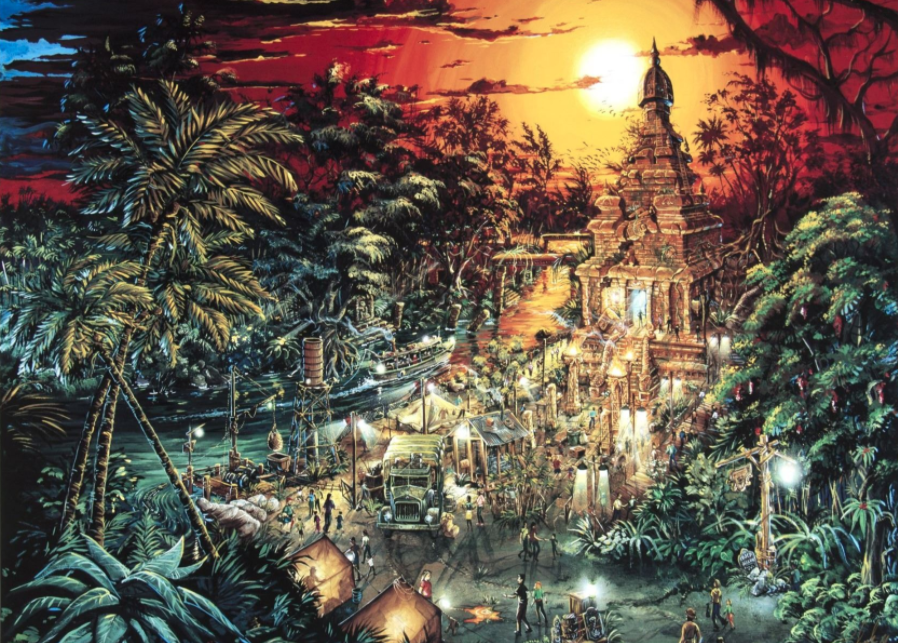
When Indiana Jones Adventure: Temple of the Forbidden Eye opened in 1995 (just as Animal Kingdom was announced), the ride was pretty unanimously held up as the most spectacular, massively-scaled, oversized, and outrageous Disney E-Ticket attractions ever. Set down in the misty jungles of Disneyland’s Adventureland, the ride casts guests as 1930s tourists drawn to an Indian lost river delta by Dr. Jones’ recent discovery of a long-buried temple… and the unfathomable treasure said to await inside…
Naturally, our Modern Marvel: Indiana Jones Adventure – Temple of the Forbidden Eye feature dives deep into the development, legend, and lore of Disneyland’s one-of-a-kind, bucket-list E-Ticket… but suffice it to say that aside from explosive effects, a sensational score, and one of the darkest mythologies ever invented by Imagineering, the true star of Indiana Jones Adventure was something a little less obvious…
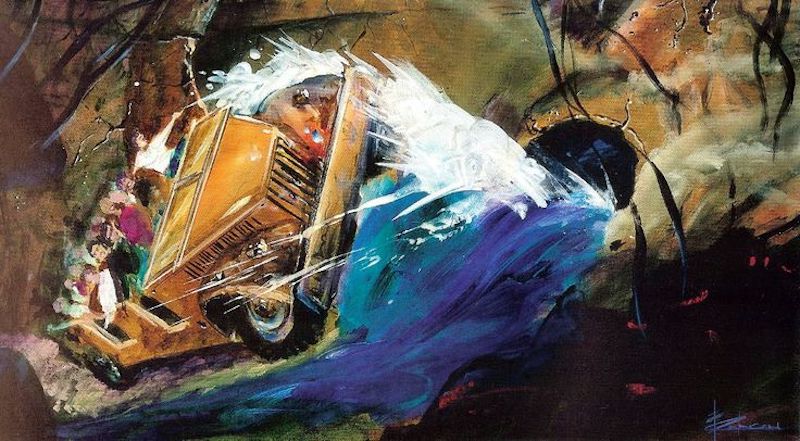
Disguised as a battered World War I troop transport, the three-row, 12-passenger body of the EMV that riders sit in is actually just a shell attached to a rolling powered chassis by way of a four degrees-of-freedom motion base. That means that even though the ride’s vehicles appear like lumbering, gas-guzzling Jeeps, they transform in the ride’s first scene. While the slot-car style chassis advances through the ride, the EMV’s passengers tilt, rumble, lift, and shuffle in a precisely-coordinated “show” of the motion base – groundbreaking enough to rank among our Seven Modern Wonders of the Theme Park World.
That means that as a vehicle traverses the temple, it can pitch, roll, sway, rumble, buck, and slam as if it’s climbing rough terrain, whipping around corners, leaning into tight turns, and shuddering to a stop. In fact, it’s said that each EMV on Indiana Jones Adventure was programmed with a subtle-but-distinguishable “personality” allowing each to react differently to the trials of the temple.
But the EMV also signaled an important narrative shift: rather than simply being observers gliding through dark ride scenes (think of drifting through Splash Mountain’s vignettes), the EMV kicked off a new genre of modern dark ride, wherein guests are in on the action.

The EMV made the ride vehicle itself a character in the story, as much a component of a ride’s storytelling as music, lights, or Audio-Animatronics – a programmable, personalized, motion-simulating tool. The EMV was a massive move forward for Imagineering… and presented a pretty compelling new opportunity back in Florida…
Creative compromise
With the budget for Disney’s Animal Kingdom under strict scrutiny in the lead-up to the park’s announcement, Imagineers responsible for Dinoland saw Indiana Jones Adventure’s innovative EMV as a perfect creative compromise….
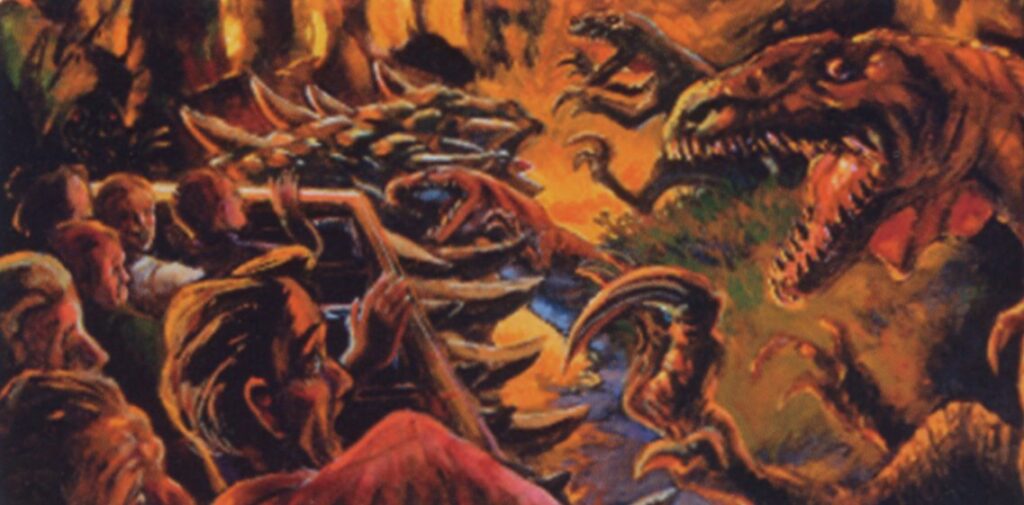
Think about it: a single EMV dark ride could combine all the thrills of the Excavator roller coaster, plus the Audio-Animatronic-based “safari” through a prehistoric jungle into a single attraction… all while introducing the highly-innovative and headlining EMV technology to Walt Disney World. Even better, the option to clone Indiana Jones Adventure’s ride system and layout would save major research & development dollars, checking every box for the increasingly-cost-conscious Eisner.
Given all of that, it’s really no surprise that Dinoland – albeit, modified from its original attraction lineup – made it into the 1995 announcement of Disney’s Animal Kingdom while Beastly Kingdom did not. (It’s often said that – through the natural project fluidity of the themed entertainment design industry and its contracted artists, architects, and writers – the raw ingredients of Beastly Kingdom could instead be found in the Lost Legend: The Lost Continent at Universal Islands of Adventure.)
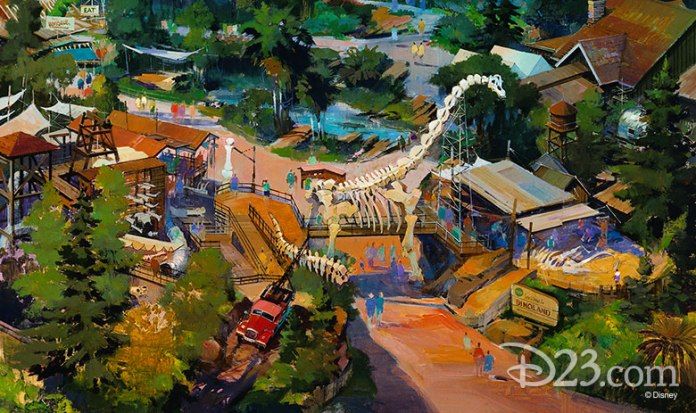
With an EMV ride as its centerpiece, the design of Dinoland took on its final form… a small-town-turned-sideshow at the confluence of three worlds: long-standing locals eager to cash in on the mother lode of prehistoric fossils in their proverbial backyards, arriving paleontology grad students transforming the town into their campus, and the scholarly Dino Institute arising from their work. (We explored the full “mythology” of Dinoland and its story in a dedicated Dinoland U.S.A. feature – make the jump to that feature to flesh out the bones of the Dinoland story.)
And there, in that Dino Institute, the most cutting edge attraction at Disney’s Animal Kingdom – a fusion of dark ride and thrill ride in one – would come to life…
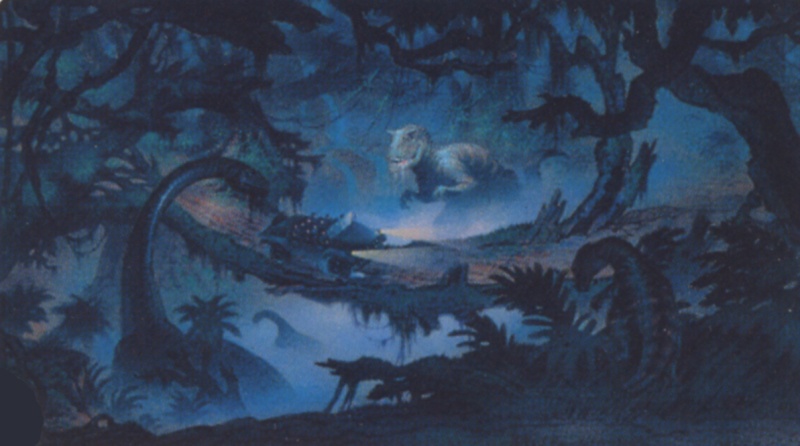
As the rare concept art above depicts, at least one initial draft of the attraction stuck closely to the Temple of the Forbidden Eye’s key scenes, including the fabled “Big Room” – here re-imagining the iconic suspension bridge as a fallen tree, with helpless guests trapped over a misty chasm while a T. rex advances on its prey.
Though not much is recorded about the development that lead to the ride that debuted in 1998, Dinoland’s high-thrill, off-roading “safari” through the jungles of the Cretaceous clearly evolved. Recasting Indiana Jones Adventure’s World War I troop transports as “CTX Time Rovers,” Countdown to Extinction would send guests on a prehistoric time-travel tour gone awry, driven by three massively motivating factors:
- a countdown, with the ride set minutes before the start of the K-P extinction event that killed off half of all species on Earth
- a rescue mission, seeking to capture and return to the present with a dinosaur in tow, and
- an escape, pursued by a merciless, hungry, and downright ugly predator…
Carnotaurus robustus
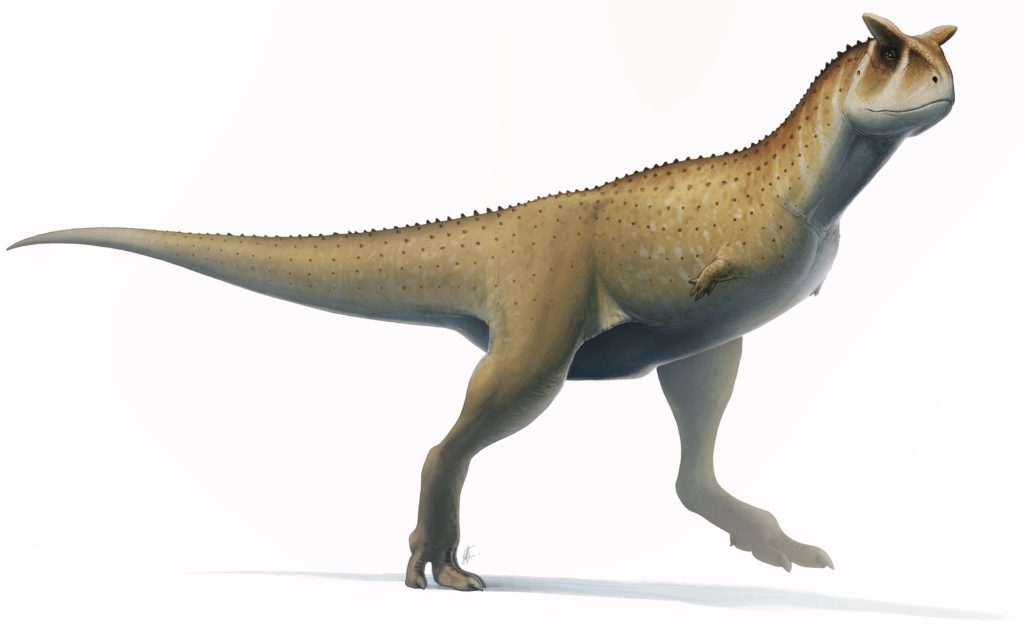
In the development of Countdown to Extinction, Rohde and the team purposefully aimed to use “lesser known” dinosaurs of the Cretaceous. Certainly in part because the Tyrannosaurus rex had become the de facto domain of Jurassic Park, a distinct antagonist was chosen for Disney’s ride: a then recently-discovered genus of meat-eater from the late Cretaceous called Carnotaurus.
Only unearthed in 1984, the 25-foot-long, 10-foot-tall Carnotaurus sastrei (the only species yet uncovered) wasn’t your typical lumbering carnivore. Fast, nimble, and lightweight with a thick neck and a deep skull, it’s believed that the creature could run as fast as 35 miles per hour (twice the speed of a T. rex). Still, its name (from the Latin for “meat-eating bull”) hints at its most distinctive feature – one never seen on any carnivorous dinosaur discovered before or since: pointed horns protruding from its skull.
In the Carnotaurus, Imagineers had found a great basis for a lesser-known yet effectively-intimidating “bad guy”… even if the character still needed some imaginative changes. For one, as Rohde wrote on his Instagram, “Carnotaurus is a weird, slender critter with really, really tiny arms. Really tiny,” with a “funky overbite”. For another, the creature’s sleek “weasel-ish” build didn’t lend itself to the mechanical requirements of supporting such a massive, moving Audio-Animatronics figure.
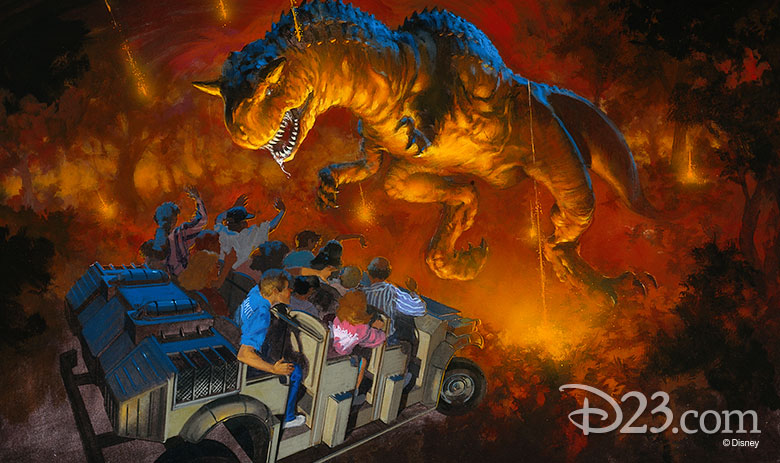
By necessity, Disney’s Carnotaurus began to diverge from its scientific ancestor. In initial sketches, Rohde and Imagineer Paul Torrigino began to adapt the creature to fit the robust metallic skeleton that would be needed to bring it to life. Rohde recalled:
“The steel in the legs needed to be thick. Once the legs were that thick, the dinosaur needed to be thick to match. Once it was that thick, it needed to be bigger proportionately, and once it was that big it needed more profound skin texture to read proportionately. Plus… we could not sell the “no arms” thing. By the time we were done, we had a huge and somewhat new animal. Not utterly implausible – but not Carnotaurus sastrei. We basically invented a Carnotaurus robustus.”

Based on Rohde and Torrigino’s sketches, Gene Whiskerson modeled a final form for Disney’s Carnotaurus – a heaving, imposing, hideous, bullfrog-faced carnivore with wild eyes and twisted horns… and yes, arms. Three of the 11 Audio-Animatronic dinosaurs throughout the ride would bring to life the “new” Carnotaurus, each louder, closer, and meaner than the last.
To instantly differentiate it from Universal’s greenish-gray T. rex and to stand out in the ride’s blacklight environment, Disney’s Carnotaurus was painted a rich, blazing red-orange; its skin embellished with exaggerated knobs, bony plates, and fleshless horns meant to add depth and texture in a second’s glance under theatrical lighting.
Interestingly, the dinosaur’s WDI-determined build and color scheme (aspects essentially invented by Imagineering to compensate for the unique requirements of the dark ride format) have since become the definitive form of the Carnotaurus in merchandising and film beyond Disney’s realm. Said Rohde, “Up to this day, I still see depictions of Carnotaurus as a massive thorny bulldog of a creature instead of the sleek, funky overbite, weasel-ish critter it was. I wonder how many of these depictions could be traced back to our design solutions for those gigantic steel ankles on the Audio-Animatronics figure we built.“
Think about it, though: the fact that the popular image of the Carnotaurus (perpetuated by action figures, plush, and even Jurassic World) as aligning with the invented hallmarks of Disney’s theme park-ready species sort of stands as living proof of Dinoland’s underlying thesis – that dinosaurs are shaped by pop culture as much as the inverse.
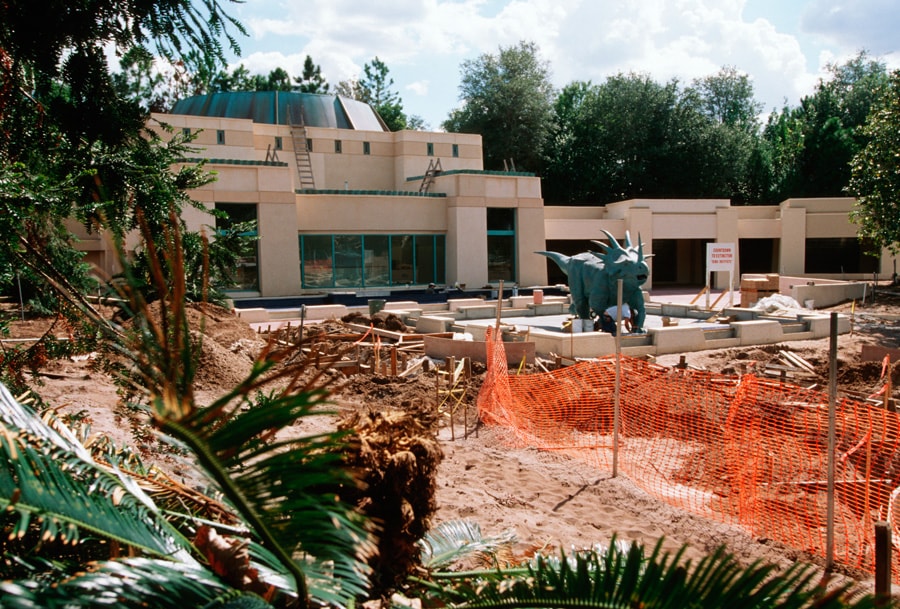
Anyway, a custom showbuilding was constructed south of Dinoland, housing a near-exact copy of Indiana Jones Adventure’s track layout (but for a few literal cut corners). Unlike Indy’s half-mile queue (necessitated by the showbuilding’s position outside of Disneyland’s berm), Countdown to Extinction was disguised only by the facade of the scholarly “Dino Institute” museum. (In a bit of Imagineering wizardry, trees planted on the roof between the museum facade and the warehouse beyond subconsciously insinuate that the museum is far too small to contain such an extensive ride.)
In Countdown to Extinction, Imagineers had upped the ante… and the risk. The thrilling chase through the final moments of the Cretaceous period would indeed bring Animal Kingdom a staggering thrill ride with incredible Audio-Animatronics and a groundbreaking ride system… but it would also be the park’s only dark ride at opening – a loud, dark, and downright terrifying anchor attraction.
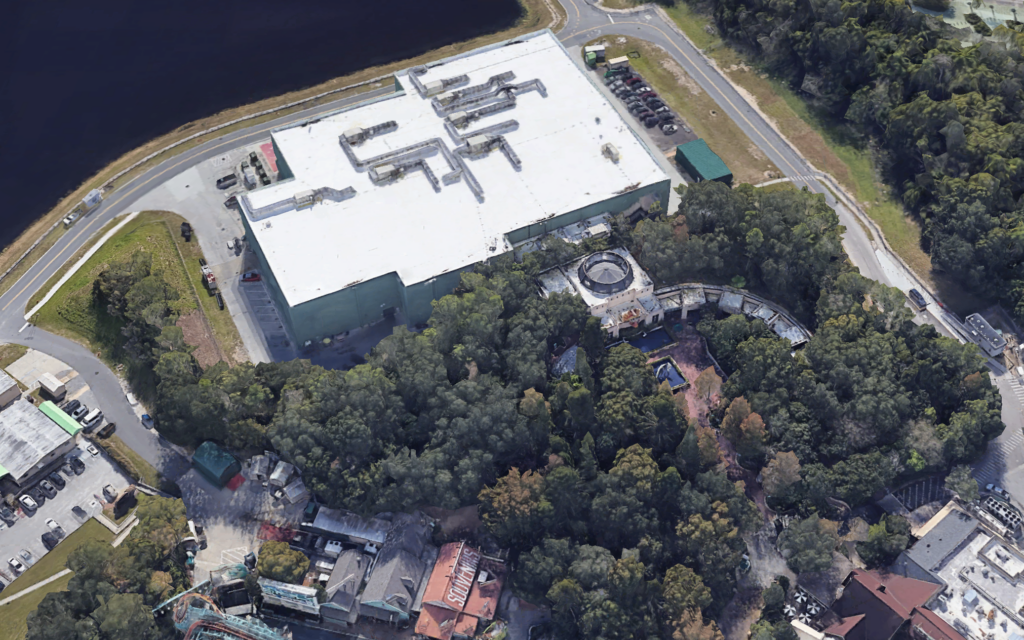
What did guests experience aboard Countdown to Extinction when Animal Kingdom opened? And more to the point, what did they think of it? Read on as we time travel to April 1998 and climb aboard Disney World’s chaotic, extinct adventure.




Re Quest of the unicorn — that sounds an awful lot like a (now-defunct) attraction called ‘Adventure’ at COSI in Columbus, Ohio. Which sounds a bit crazy, except that – if I recall correctly – Adventure was designed by a firm that was created by Imagineers who were let go after AK’s opening. (Our zoo also benefitted from this experience; there are sections built in the early 2000s that are Disney-quality, reportedly due to being designed by ex-Imagineers who had worked on AK.)
Adventure began with a pre-show explaining the premise (which, incidentally, felt very much like Indiana Jones’ in Disneyland – almost uncannily so, now that I think back on it). Upon exiting the pre-show, visitors entered an enormous set with plenty of opportunities to explore. The exhibit was essentially divided into four areas (a maze, a cavern, a gravel pit, etc.), with a “locked” central ‘observatory’. The objective was to obtain a four-piece “code”, which in turn would unlock the observatory. In each area, visitors located several ‘animal symbols’ (indicated by small bronze statues), as well as a larger “stone” statue. When visitors typed the three animals into the keypad, the (audio-animatronic) statue would “come to life”, since a little song, and display a “piece of the code”. After gathering all four pieces, visitors then went to the observatory, put the code in, and were granted entry. (This then led to a ‘second level’, far more complex than the first — almost like a predecessor to modern-day escape rooms.)
Unfortunately, it closed a few years ago, but it was one of my favorite activities in the city and immediately sprung to mind upon reading your description of Quest of the Unicorn.
Happy to provide any add’l information as I’m able — it’s been a few years since my last visit (when the space closed), but I spent enough time in there that I should have decent recollection!
Carrie! You are talking about one of my favorite things that’s ever existed – and the subject of an upcoming deep dive here. Adventure was genuinely the attraction that made me who I am. I was lucky to experience it as a kid, and then to work at COSI for about a decade after college. I’m so glad you brought up this relationship, because Quest for the Unicorn always felt like a high-capacity “twist” on Adventure, perfectly appropriate for Animal Kingdom. But wow, please stay tuned because I am worried no one’s gonna “get” my Adventure piece, so I’m glad to know that you will. Haha. Thank you!
It was always one of my fave ride at animal Kingdom
Brilliant article. I would classify this ride as a classic. Mainly because of its original concept. There might have been a plan for a future IP tie in, but this ride is original nightmare fuel. I’d say celebrate the Genious of the rides first iteration as a lost legend.